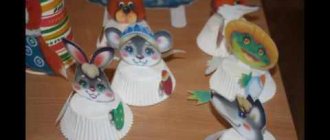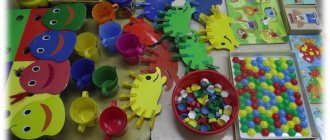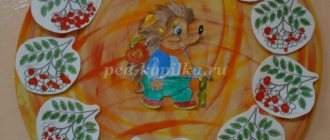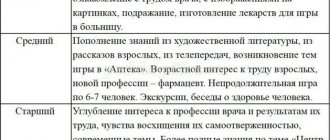Games—construction activities for young children
Ekaterina Trebushnaya
Games—construction activities for young children
Construction is one of the most favorite children's activities. It is not only exciting, but also useful for the baby. Construction creates the necessary foundation for the comprehensive development of the child.
Design goals:
Contribute to the active formation of technical, spatial and mathematical thinking.
Develop observation, curiosity, intelligence, resourcefulness, perseverance.
To form the need for creative activity, hard work, independence, activity, patience, accuracy.
The tasks for this section are:
Formation of cognitive and research activities in children.
The desire for mental activity.
Introduction to the world of technical invention.
From 1 year to 2 years.
Lesson No. 1
Topic: “House made of cubes of the same color and size.”
Goal: Teach children to play, put cube on cube. Activation of children's passive and active vocabulary through words: take, make, put, house, put the cat on the house, onomatopoeia meow-meow.
Material: 4 cubes of the same color and size (rib length 8-10 cm, cat toy for each child.
Progress of the game-lesson: children with a teacher sit on the floor. The teacher shows how to build the building. I'll take a cube, then another cube. Then we read the poem:
Tili-bom! Tili-bom!
“We built a house!
Then we put the cat on top and say:
Pussy sits on the house
And he looks at you and me.
Meow-meow - says.”
And now Tanya will build a house for her pussy. Take a cube, then another cube. What did they build? house Who lives in the house? Pussy. How does a pussy talk? Meow meow.
Lesson No. 2
Topic: “House made of cubes of the same size and two colors.”
Goal: continue to teach how to play, put cube on cube. Activate children's passive and active vocabulary through words and onomatopoeia: take, do, put, house, put the dog, woof-woof. Teach children to distinguish cubes by color.
Material: 4 cubes of the same size (rib length 8-10 cm) in two colors, a dog toy for each child.
Progress of the game - activities: children with a teacher sit on the floor. The teacher shows how to build the building, while naming the color of the cube. “I’ll take a yellow cube, another yellow cube, a red cube on top, another red cube:
“We built a house!
Tili-bom! Tili-bom!
Who will live in it?
Shows the dog. "Who is this? Dog. She will live in the house." He puts a toy on top of the building: “What does the dog say? Bow-wow".
“And now Tanya will build a house for the dog. Take a yellow cube, another yellow cube, then a red cube, another red cube. What did they build? Little house." The child puts the dog on the house, the teacher reads a poem:
“A dog came to us,
Smart dog!
Plays with the children
Barks very loudly: woof-woof-woof!
Lesson No. 3
Topic: “House made of cubes of different sizes of the same color.”
Goal: teach children to build a house from two different sized cubes. Continue learning to understand verbal instructions. Pronounce onomatopoeia, play with toys.
Material: 2 cubes, contrasting in size (rib length 10 and 5 cm, one primary color (to choose from, a cockerel for each child.
Progress of the game-lesson: children with a teacher sit on the floor. The teacher places a cube in front of them, drawing attention to it with the words: “Look, this is a cube! What a big cube! Tanya, give me a small cube (it stands in front of the baby, it’s a small cube. The teacher takes a small cube and puts it on a large cube, puts a cockerel on top of the house and says:
"Cockerel, cockerel,
golden comb,
That you get up early
Don't you let the kids sleep?
Ku-ka-re-ku!
How does a cockerel sing a song? Tanya, take a big cube, now a small cube. A cockerel flew in and sang: ku-ka-re-ku!
Lesson No. 4
Topic: “House made of cubes of two sizes and colors.”
Goal: continue to learn to distinguish cubes by size, without being distracted by color, learn to understand the words: big, small, build a house from two cubes of different sizes and two colors. Follow verbal instructions, pronounce onomatopoeia, play with toys.
Material: 2 large red cubes and 2 small yellow cubes. Small toys for each child to play with.
Progress of the game-lesson: Place large red and small yellow cubes in front of the children, and the same ones in front of the teacher. He builds a house in front of the children and says: “I will build a house. I bet a big cube. What a big cube! Take the same large cube. I'll take a small cube and put it on top of the big one. Take a small cube and place it on the big one. A bird flew to my house (puts a bird on the house, who lives in your house? Children choose a toy, put it on the house, imitate the animals.
Lesson No. 5
Topic: "Blue Tower".
Goal: to teach children to act by show, to focus on the color blue, to promote verbal communication.
Material: 4 red cubes for children and 4 blue for display, a bird for each child.
Progress of the game - activities: The teacher shows and explains in detail the process of constructing a building (uses blue cubes). “I will find a blue cube, put it on the table, take another similar cube and put it like this on this cube, equalize them. Now I’ll take another cube and put it on top, I’ll also trim it. This is how the tower turned out. A bird flew to the tower.
A little bird flew to us.
I will give some grains to the little bird.
A small bird pecks grains.
A little bird sings a song.
Now build the same turret.
From 2 to 3 years
Lesson No. 1
Topic: “Tower of 5 cubes and a prism.”
Goal: to teach children to act according to the teacher’s instructions, to focus on the color blue, and to promote verbal communication.
Material: 5 blue cubes and a prism for each child.
Progress of the game-activity: first examine the sample with the children, explain in detail and show how to do it (“Cube on cube, cube on cube, and so you get a tower”)
Exercise the children in naming the building: “Tanya, what do we have here? That's right, the tower, what is it? Tall."
Lesson No. 2
Topic: "Turret low and high."
Goal: continue to teach how to build buildings according to the model and verbal instructions of the teacher. Learn to change the height of a building by building it higher. Focus children's attention on red and blue. Develop imagination and constructive creativity.
Material: blue and red cubes and prisms, matryoshka dolls according to the number of children.
Progress of the game-lesson: two towers of different heights are built on the teacher’s table. "What is this? (tower). What tower is this? (High). What color is it? (Red). That's right, it's a tall, red tower. What can you say about this tower? (she is low and blue). A matryoshka came to us, walked around the tall red tower, and went to the low blue one. Now build your towers, and the nesting dolls will also come to them and walk around the towers.” After the children have built turrets, ask: “Masha, what kind of turret do you have? What about you, Misha? Invite the children to play with nesting dolls near their towers.
Lesson No. 3
Topic: “Festive tower made of cubes and bricks.”
Goal: continue to teach how to build buildings according to the model and verbal instructions of the teacher. Continue to learn how to analyze a sample using the exact names of the parts of the construction kit. Develop imagination, constructive creativity, learn to use parts of different colors.
Material: a set of building materials, nesting dolls.
Progress of the game-lesson: a tower is built on the table. “What was built? Tower. What tower? Low. What parts are the base of the tower made of? (bricks) yes, they are placed on a narrow short edge, and another brick is placed on top of them. What's at the very top of the tower? (a cube and a flag on the cube). What a beautiful, festive tower. The matryoshka came, she really liked the tower, she began to walk around the tower. When the children complete the task, the teacher asks: “How did you build your tower? How did the tower turn out?
Lesson No. 4
Topic: “By verbal instructions.”
Goal: Continue to teach children how to build using a variety of materials. To consolidate the knowledge acquired in previous lessons, to encourage children to engage in joint play with other children.
Material: a set of building materials, nesting dolls.
Progress of the game - activities: build samples of different towers. Invite the children to build a tower that they like.
The teacher does not explain the methods of construction, but only helps with questions, advice, reference to a model, and action (if necessary).
Lesson No. 5
Topic: “The path is narrow.”
Goal: to continue to teach children to perform basic actions with similar building material, placing bricks against each other with a narrow short edge. Focus on the color green. Develop a desire to communicate, continue to teach game actions.
Material: green bricks, small toys.
Progress of the game-lesson: the teacher reminds the children of the poem “Little feet are galloping along the path” and offers to build a path for a doll or bunny. Shows and explains in detail how to apply bricks to each other, how to align them. Having built a path, the child plays (you can decorate the path along the edges with Christmas trees, walk along it with toys, etc.)
The teacher teaches children play actions. First he leads the doll himself, then the child leads the doll along the path. Constantly activates the children’s speech: “What have you built? What's your doll's name? Who are we leading along the path?
SECTION 2. WHAT A BABY FROM 1 TO 3 YEARS CAN BUILD FROM CONSTRUCTION TOYS
At an early age, the baby learns from his mother not only the names of parts, but also how to operate with them - elementary methods of construction. Let's get acquainted with these design methods for the little ones, I give them in order with a gradual complication of the tasks:
Method 1. Place the construction parts horizontally and vertically and see that this changes their stability.
For example:
- The cubes can be placed horizontally to create train carriages. Or you can put it vertically - make a turret.
- The bricks can lie horizontally on the table, and then we will have a path. It may be different. You can make a narrow path if you connect the bricks with the narrow side. Or you can use a wide path if you connect them to each other with their long side.
- If you place the same bricks vertically on a table next to each other, you will no longer get a path, but a fence!
- If you place a brick vertically next to the cube, you get a chair. And if you put the same brick horizontally on the same cube, you will get a completely different building - not a chair, but a table!
Method 2. Lay the parts one on top of the other, make overlaps. This is how we get houses and gates.
Method 3. Close the parts into one ring, forming a closed space.
Examples:
- Example 1. From bricks placed on edge, we build a fence for chickens, cows, make a park, make a yard for walking nesting dolls and other small figures of people and animals.
- Example 2. We can also build a garage for a toy car, into which it will drive through a gate.
- Example 3. You can even take a tram or bus with your child. To do this, we build a closed space from bricks, and after that we place seats for passengers and a place for the driver in it. We can move one of the bricks to the side when passengers enter the cabin. This will be the door. You can come up with many options for “arranging” such a bus.
Our main task is for the child not just to repeat after us some new method of action, but to begin to use it in his own independent games. Therefore, we vary the games and show one way of design using the example of different buildings and different game plots.
3. Road (Ozon, My-shop, MyToys)
There is an opinion that girls always play with dolls, and boys with cars, maybe this is partly true, but it definitely doesn’t apply to road constructors. When my daughter was given a road at the age of 2, she was so captivated by it that for about two months, every day in the morning on the floor of the nursery we were greeted by a new shaped highway. I must say that Tasya liked the construction process; sometimes he didn’t even get to the point of rolling cars. I think boys will find any construction set in the form of a car or railroad even more interesting.
For the little ones, it is very important to choose a road construction set so that the parts interlock without unnecessary effort, and the child can assemble the road himself, without the help of an adult. We played with a car construction kit from a little-known company called Dolu. I couldn’t find it for sale, so I’m giving links to the Brio railway (Ozon, My-shop, MyToys) and its analogues (Ozon, My-shop, Read).
Lego Duplo and its analogues (Ozon, My-shop)
Lego needs no introduction; it is a constructor that has been tested by time and millions of children around the world. From the age of 2, a child will be interested in building paths, fences, houses, collars, chairs, tables, as well as some simple decorations that may be needed for role-playing games. It must be said that the animals and people included in Lego sets greatly increase a child’s interest in the game and motivate them to build this or that building. For example, one of our favorite buildings is an animal zoo. First we build fences, then we organize a game with the sale of tickets and visits to animals.
True, when buying a role-playing set with animals and other figures, you need to be more careful. Very often, sets are made in such a way that they limit the child’s imagination to only one version of the game, and also contain ready-made elements that can be used in one single way. Thus, the presence of ready-made roofs, walls, tables, chairs in the set deprives the child of the opportunity to dream up and figure out how to make the same thing from a construction set himself. Therefore, try to buy construction sets that contain many universal elements and as few ready-made solutions as possible.
If you want a construction set with even larger parts than Lego Duplo, then you can choose, for example, the Mega Blocks construction set (Ozon, MyToys). But generally speaking, all Lego analogues are noticeably inferior to the original in terms of precision of parts and quality of plastic.
Constructor “Zolo” (Ozon, My-shop)
A completely unusual construction set with oddly shaped parts and a non-standard principle of connecting parts. Such a construction set is not needed at all to build houses or fences; this construction set is needed to excite children’s imagination and create unusual shapes. You can build the most incredible creatures from it (perhaps yours will be weirdos or aliens). The creation process is very exciting, you can laugh heartily, giving free rein to your imagination. Well, when the creatures of alien origin are ready, you can come up with funny names for them like five-legged, big-eyed or bubuzyaki.
I think the most valuable thing about this construction set is that it helps a child learn to think outside the box: after all, it is absolutely not necessary for an unknown alien to have two eyes and two legs, and why does he need a torso at all and why does his nose have to be on his head? In general, we fantasize. Perhaps someone will consider this designer crazy, but it is my favorite.
I really hope that the Zolo construction set will appear in stores again, because it simply has no analogues. The Ogobild construction kit is somewhat similar to it, but with it, it seems to me, it’s better to fantasize about inanimate, technical topics. And it is much more difficult to fasten parts in Ogobild, so it is more suitable for children after 3-4 years.
"On a boat"
Goal: to teach how to build a boat from different parts, distinguishing them by shape, color, size, enriching the vocabulary with new words.
Material: a set of building materials, matryoshka dolls - large and small.
Class.
According to the plot, Masha wants to ride a boat. Invite your child to build a boat for her.
Take two plates and place them parallel to each other. Ask your child to hold up the prism - this will be the bow of the ship.
During the game, ask questions about the colors of the parts that are used in the construction of the boat.
Cover the back of the vessel with a brick, and place another one in the center for the bench on which Masha will sit.
Demonstrate a matryoshka doll rolling on water.
Masha has a friend, a little nesting doll, who also wants to ride a boat.
Invite your child to build a boat for her himself.



